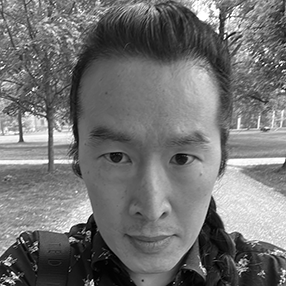3. (Jeong Seon’s Album of Mount Geumgang)
Jeong Seon began his career
in the low-ranking position
of adjunct professor
of administrative iconography.
Breaking with convention,
he diligently studied the birth of a brushstroke
by gazing at
the surviving itinerary of an unrealistic river, at the
rippling rapport of vegetation and rain.
He preferred to observe and preserve
the essential concerns of a superfluous calligraphy
and thus did not succeed
in his civil exams.
When he was thirty-six years old,
at the
northern border of poetry and astronomy,
Jeong Seon
repeatedly painted a series of eccentric circles
and so gained access
to the crystal bridge
between ink and atmosphere.
His artist name became
Magistrate of Waterfalls, and
Jeong was said to have annotated
the nine-bend stream of time.
Analysis of Jeong’s preeminent painting,
The Four Horsemen at Big Dipper Pavilion
reveals
wished for figures in revolutionary mansions—
a remembrance external to its style.
Particularly noteworthy
is a spiked and turquoise perspective
and a diagonal
dismemberment of silk.
The painting was able to route
Jeong’s identity around
a dominant focal point, along wavy and uncertain patterns,
and finally
through environmental conditions of blue.
One can grasp
his aesthetics of juxtaposition
as long as one is covered in mist, or enriched
by hemp-fiber clouds, but
not lost
horizontally in the heart of the sea.
In Transmitting the Vertical Immensity of Coniferous Light, characteristic
of his more mature style,
Jeong’s command of a
rhythmically surging semicircle
evokes the overwhelming
articulation of
how a higher philosophical plane could be
so astounded by the mundane.
Here, the twelve thousand pillars of basalt
do not overwhelm the composition;
rather, they commemorate
that sunrise is a landscape’s subsidiary entryway into the
verdant flow of the visible.
A yangban painter once
wrote:
“According to where he sits, Jeong Seon
resembles a rugged jar-shaped diamond,
an arrangement of Mi dots,
or a panoramic dichotomy in detail.
Now at age seventy-two he is
much more than an amplification of the massiveness of soil.”
One especially
beautiful example of Jeong’s expansive style
is today known as
A Documentary Record of Aristocratic Time Travel,
which illustrates
the reinterpreted bodies
of a great-great-grandfather
and his great-great-grandchild
listening to the collision of dark energy.
Jeong’s strong lines here
impart a wide-angle awe
that connects the flow of inner color
to outer air, a sense that even hawks could survive
in our world
of dissimilar forms.
Literati writing under a predated nom de plume
compiled ninety-six poems about the painting
and published them in the Album of
Liquid Astonishment.
By the time the colophon was written,
the appended poems
had been vicariously exaggerating
their own images
—as if they were looking
through the zoom lens of a camera
at a human eye.
Copyright © 2018 by Michael Leong. Originally published in Poem-a-Day on August 7, 2018, by the Academy of American Poets.
“‘Jeong Seon’s Album of Mount Geumgang’ is the third section of my experimental ekphrastic sequence ‘Transmitting the Vertical Immensity of Coniferous Light.’ This sequence was commissioned for a reading at The Metropolitan Museum of Art in response to the exhibition Diamond Mountains: Travel and Nostalgia in Korean Art, which featured ‘artwork from the eighteenth century to the present inspired by what may be the most famous and emotionally resonant site on the Korean peninsula.’ The Diamond Mountains, also known as Mount Geumgang, are located in present-day North Korea and are largely inaccessible to contemporary visitors. These poems only draw on words found in the exhibition monograph Soyoung Lee’s Diamond Mountains and mimic the book's structure from Daniel H. Weiss’ ‘Foreword’ to the four art history essays by Lee, Lee Soomi, Chin-Sung Chang, and Ahn Daehoe that follow it. In remixing Lee Soomi's essay, which details how Jeong revolutionized Korean landscape painting in the late Joseon period, this poem pays tribute to the practices of both the artist and the art historian.”
—Michael Leong

